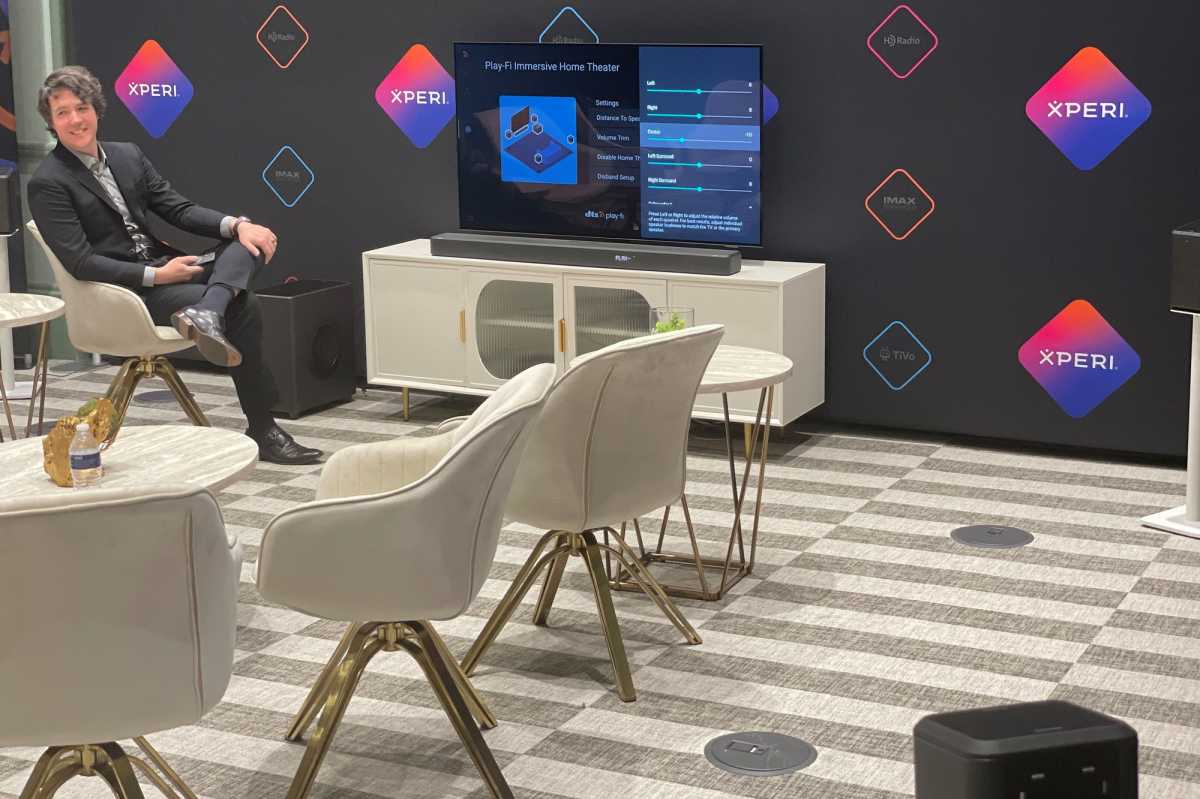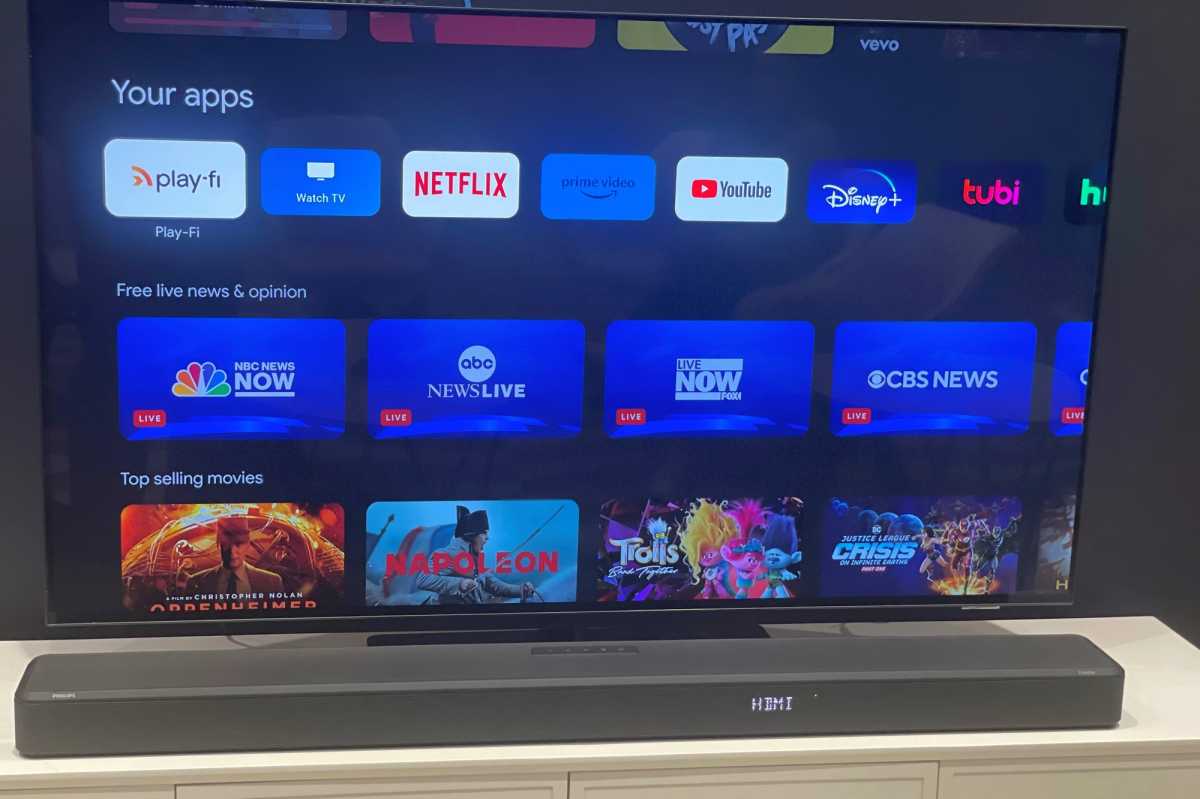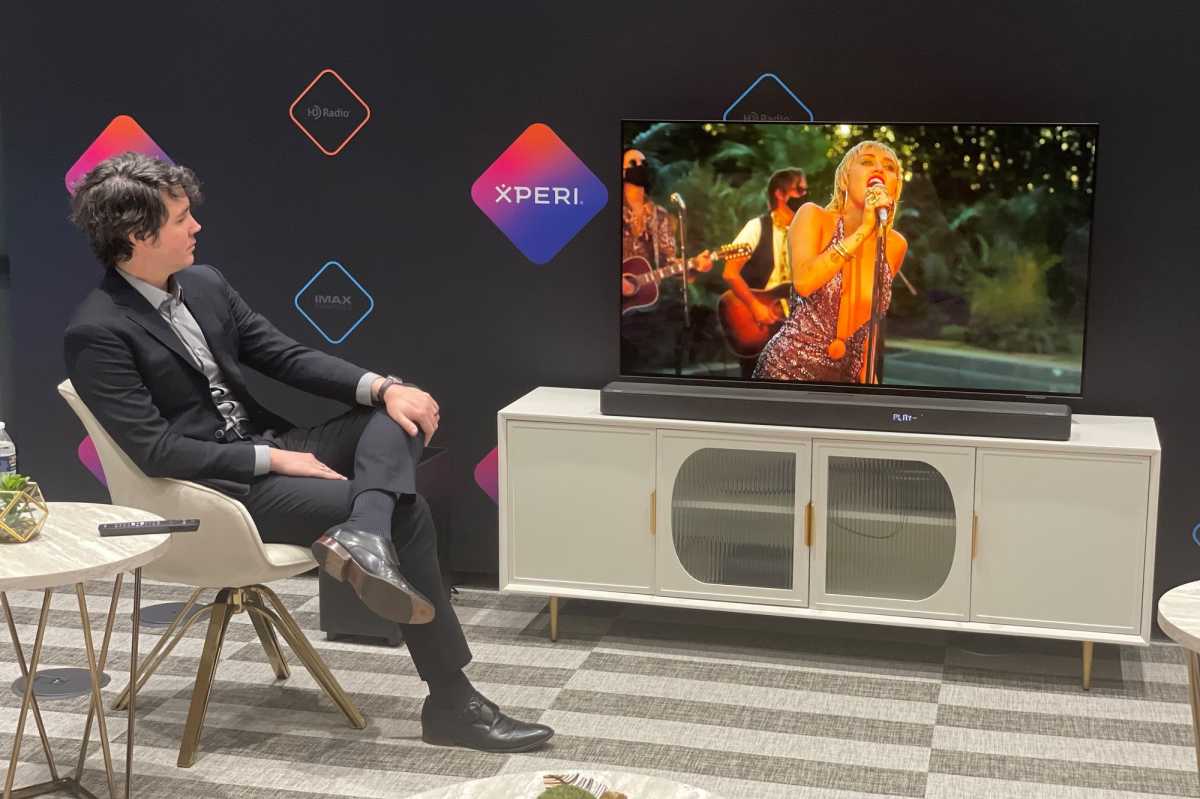You love being immersed in spatial audio, but aren’t thrilled with the clutter that comes with the complexity of an A/V receiver and yards of speaker wire snaking around your room and climbing up its walls. You’ve heard soundbars that claim to deliver Dolby Atmos and DTS:X from a single cabinet, but dismissed them as unacceptable compromises, even when accompanied by a wireless subwoofer. Can no one deliver the audio experience you crave?
Xperi says it can with DTS Play-Fi Home Theater, a 12-channel wireless surround-sound architecture on display at CES last week. Tapping the Wi-Fi Direct standard (more on that in a bit), DTS Play-Fi Home Theater components connect directly to one another without burdening your Wi-Fi router or your wireless network. And the only cable each self-powered speaker in this system needs is a power cord.

DTS product manager Justin Gibbins demonstrating DTS Play-Fi Home Theater streaming surround sound to a room full of speakers, without wires.
Jonathan Takiff/Foundry
DTS product manager Justin Gibbins treated me to a private tour of DTS Play-Fi Home Theater at the show last week, and I was impressed by both the clarity and maxed-out spaciousness of the wireless sound signals humming in front, around, and overhead, courtesy of the Dolby Atmos-encoded Netflix series Formula 1: Drive to Survive and Miley Cyrus’ sense-around cover of “Sweet Jane.” Hmm, was she even born when Velvet Underground cut the original?
Long familiar with DTS Play-Fi, I fretted that the standard’s sonic quality would be compromised in this new variation, given that its wireless bandwidth is now being tasked with carrying a dozen channels, where it was expected to handle just two–six at most–in its original form. The demo assuaged my concerns.
“Each channel is delivered in essentially the same quality that it arrives,” Gibbins explained. “It will be anywhere from the lowest mono 8kHz signal you might get from a radio stream, all the way up to stereo 24-bit/96kHz coming from a music source like Tidal, Amazon, or whatever. And the same goes for surround sound. With Dolby Atmos- or DTS:X-based content, what we’re delivering should generally be the same bit rate and quality that you’d get from the over-the-top streams.”
Your home Wi-Fi network only delivers a two-channel audio stream to your TV or soundbar. That component uses its own processing power to then unwrap a multiplicity of channels. DTS circuitry then gets into the game, utilizing Wi-Fi Direct protocols to spread this wealth of signals to receiving speakers, “leaving your home Wi-Fi network out of the process,” Gibbins said.

A Philips Fidelio FB 1 soundbar anchored the demo.
Jonathan Takiff/Foundry
I was even more impressed by the minimalist collection of gear required to bring the show to life. There was none of the nightmarish complexity that ruins home decorators’ sleep and makes custom installers, with their “Sure, we can hide those wires” promises, piles of moolah.
DTS Play-Fi Home Theater can theoretically juggle up to 12 discrete channels in different ways. At present, it’s being done in a 7.2.4 layout: That’s 7 main speakers; 2 subwoofers, sharing a single channel; and 4 up-firing drivers for height effects. In addition to Dolby Atmos, DTS:X, IMAX Enhanced, and PCM source material, the distribution format can also work with signals up- or down-mixed by a streaming service, a soundbar, or the TV itself. Should the television have DTS circuitry built in, there’s an option to use the TV’s internal speakers as the front center channel.

DTS product manager Justin Gibbins streamed Miley Cyrus’ cover of Velvet Underground’s “Sweet Jane.”
Jonathan Takiff/Foundry
DTS Play-Fi Home Theater should even work with Dolby’s new FlexConnect solution for custom tuning and balancing disparate and oddly placed speakers in a spatial-audio setup. Dolby’s solution sounds like a variation on the speaker tuning that Harman is working in its new JBL One platform.
“The idea is we’re just acting like a data pathway for this audio information to go wherever it needs to go,” said Gibbins. “So, we’re trying to play nice with everybody in that regard.”
The big question is will home-theater equipment makers go along with the gambit? My demo was built around a Philips flat-screen telly with Play-Fi Home Theater processing onboard, a set that’s currently sold only in Europe. When I asked Gibbins which other television makers have this circuitry, he reeled off the brand names Telefunken, Loewe, and Vestel—other TV makers that have no presence in today’s U.S. market.
The CES demo was also fleshed out with a bunch of Philips-branded Play-Fi speakers that are available Stateside: a multi-channel Fidelio FB 1 soundbar ($750), a Fidelio F1W wireless subwoofer ($500), and four of its compact Wi-Fi FS1 speakers ($260 each.) The latter push a monaural channel forward and a separate spatial-effects channel upward.
I was told that top-of-the-line soundbars from Hisense and TCL—available now or coming soon to the U.S. market—are also capable of DTS Play-Fi Home Theater processing. But pretty much any Play-Fi-compatible Wi-Fi speaker made over the format’s 12-year history—from the likes of Definitive Technology, Polk, and SVS—can get in on the action, too, functioning as single channels in a DTS Play-Fi Home Theater setup.
There have been reports TCL will take the plunge sometime in 2024 to bring the first DTS Play-Fi Home Theater televisions to the U.S. market But the company had zero to say about the subject at CES last week.
Watch this space.


